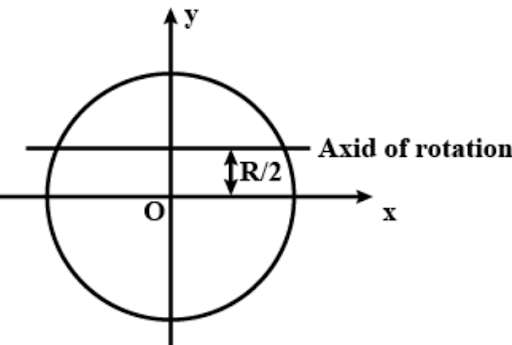
Moment of inertia of a circular loop of radius R about the axis in the above figure is:

A. \[M{R^2}\]
B. \[\dfrac{3}{4}M{R^2}\]
C. \[\dfrac{{M{R^2}}}{2}\]
D. \[2M{R^2}\]
Answer
223.5k+ views
Hint:To calculate moment of inertia for rotation about an axis through an object, two theorems are used. One is the parallel axis theorem and another is the perpendicular axis theorem. Both are used depending upon the situations given in the question. In this question, we will use the parallel axis theorem to calculate the moment of inertia of this object about the given axis.
Formula Used:
The moment of inertia, \[I\] of the circular loop due to rotation about an axis passing through its centre O is given by:
\[{I_c} = \dfrac{{M{R^2}}}{2}\] ---- (1)
Theorem of parallel axis,
\[I = {I_C} + M{h^2}\]
Where, \[I\]= Moment of inertia about the given axis
\[{I_C}\]= Moment of inertia about the axis passing through the centre of the body
M = mass of the body
h = distance between the two axes
R = the radius of the object.
Complete step by step solution:
The moment of inertia, \[{I_c}\] of the circular loop due to rotation about an axis passing through its centre O is given by:
\[{I_c} = \dfrac{{M{R^2}}}{2}\] ---- (1)
From the theorem of parallel axis,
\[I = {I_C} + M{h^2}\]---- (2)
In the given question, the new reference axis is at a distance \[R/2\] from the axis passing through the centre O of the loop,
Hence \[h = R/2\]---- (3)
Substituting values from equations (3) and (1) in (2), we get,
\[I = \dfrac{{M{R^2}}}{2} + M{\left( {\dfrac{R}{2}} \right)^2}\]
\[\Rightarrow I = \dfrac{{M{R^2}}}{2} + \dfrac{{M{R^2}}}{4}\]
\[\Rightarrow I = \dfrac{{3M{R^2}}}{4}\]
\[\therefore I = \dfrac{3}{4}M{R^2}\]
Hence option B is the correct answer.
Note: If we have to calculate the moment of inertia about an axis parallel to the axis passing through the centre of the object, we use the theorem of the parallel axis. When the body has symmetry in about two out of three axes in a 3D plane, the perpendicular axis theorem is used. We have to calculate the perpendicular distance between the particle and the axis of rotation to determine the moment of inertia of a complete system of particles. In this way, a moment of inertia of a particular solid depends on the dimensions of the solid as well as the axis of rotation.
Formula Used:
The moment of inertia, \[I\] of the circular loop due to rotation about an axis passing through its centre O is given by:
\[{I_c} = \dfrac{{M{R^2}}}{2}\] ---- (1)
Theorem of parallel axis,
\[I = {I_C} + M{h^2}\]
Where, \[I\]= Moment of inertia about the given axis
\[{I_C}\]= Moment of inertia about the axis passing through the centre of the body
M = mass of the body
h = distance between the two axes
R = the radius of the object.
Complete step by step solution:
The moment of inertia, \[{I_c}\] of the circular loop due to rotation about an axis passing through its centre O is given by:
\[{I_c} = \dfrac{{M{R^2}}}{2}\] ---- (1)
From the theorem of parallel axis,
\[I = {I_C} + M{h^2}\]---- (2)
In the given question, the new reference axis is at a distance \[R/2\] from the axis passing through the centre O of the loop,
Hence \[h = R/2\]---- (3)
Substituting values from equations (3) and (1) in (2), we get,
\[I = \dfrac{{M{R^2}}}{2} + M{\left( {\dfrac{R}{2}} \right)^2}\]
\[\Rightarrow I = \dfrac{{M{R^2}}}{2} + \dfrac{{M{R^2}}}{4}\]
\[\Rightarrow I = \dfrac{{3M{R^2}}}{4}\]
\[\therefore I = \dfrac{3}{4}M{R^2}\]
Hence option B is the correct answer.
Note: If we have to calculate the moment of inertia about an axis parallel to the axis passing through the centre of the object, we use the theorem of the parallel axis. When the body has symmetry in about two out of three axes in a 3D plane, the perpendicular axis theorem is used. We have to calculate the perpendicular distance between the particle and the axis of rotation to determine the moment of inertia of a complete system of particles. In this way, a moment of inertia of a particular solid depends on the dimensions of the solid as well as the axis of rotation.
Recently Updated Pages
JEE General Topics in Chemistry Important Concepts and Tips

JEE Extractive Metallurgy Important Concepts and Tips for Exam Preparation

JEE Atomic Structure and Chemical Bonding important Concepts and Tips

JEE Amino Acids and Peptides Important Concepts and Tips for Exam Preparation

Electricity and Magnetism Explained: Key Concepts & Applications

JEE Energetics Important Concepts and Tips for Exam Preparation

Trending doubts
JEE Main 2026: City Intimation Slip Expected Soon, Application Form Closed, Exam Dates, Syllabus & Eligibility

JEE Main 2026 Application Login: Direct Link, Registration, Form Fill, and Steps

Understanding the Angle of Deviation in a Prism

How to Convert a Galvanometer into an Ammeter or Voltmeter

Ideal and Non-Ideal Solutions Explained for Class 12 Chemistry

Hybridisation in Chemistry – Concept, Types & Applications

Other Pages
JEE Advanced Marks vs Ranks 2025: Understanding Category-wise Qualifying Marks and Previous Year Cut-offs

Mechanical Properties of Fluids Class 11 Physics Chapter 9 CBSE Notes - 2025-26

Units And Measurements Class 11 Physics Chapter 1 CBSE Notes - 2025-26

Degree of Dissociation: Meaning, Formula, Calculation & Uses

Understanding Electromagnetic Waves and Their Importance

Understanding Atomic Structure for Beginners




